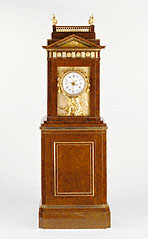• This clock is composed of what shapes? (Rectangular body, triangular
pediment, circular clock face.)
• The artist used a vertical format in this work of art. What components of the clock's design emphasize its vertical
composition? (The triangular pediment pointing up; the narrow, telescoping case; the rectangular columns in the
frieze above the clock face; and the tapering
finials on top.)
• Does this clock remind you of a building? Where on the clock do you see references to architecture? What kind of a
building does it resemble to you? (The clock incorporates many architectural elements, including a cornice, pediment and
tympanum, frieze,
balustrade, and stepped base around the middle as well as finials, and columns. This clock looks like a
tower, an elongated temple, or a civic building.)
• How would you describe the figure supporting the clock face? Based on his posture, clothing, and props, whom do you
think he might represent? (The muscular, mature, stooped figure supporting the clock is the Titan Chronos. As the
personification of time and father of
Jupiter, he is also known as Father Time. His wings tell us he is a divinity,
his scythe represents the death that creeps toward us with the passing of time.) |
This clock was one of the most popular models produced by the German workshop run by David Roentgen and Peter Kinzing.
The vertically symmetrical case is covered with a simple maple
veneer, while a gilt-bronze
relief symbolizing time frames
the clock's face. Chronos (Father Time) supports the clock dial, and the garland over the dial marks the passage of the
year, with its flowers for spring, wheat for summer, grapes for autumn, and holly leaves for winter. The coiled snake that
forms the hands of the clock could be a symbol of eternity and the circle of life.
Classical architectural elements can be found throughout the case. A frieze directly above the clock includes masks of Diana, Roman goddess of the hunt, and
Apollo, representing, respectively, night and day. The pediment above the frieze depicts a lyre, symbol of Apollo
who oversees the passage of time and is the patron of music. The top of the clock is decorated with a balustrade and urn-like
finials.
Although the clock once played different tunes when it chimed, the movement (the mechanical part of the clock) no longer works. Other examples of this clock
type included a gilt-bronze statuette of Apollo playing his lyre, mounted within the balustrade on the top of the case.
Clocks were accurate enough in this period to allow for precise mapmaking and world travel. Europeans were becoming more
dependent upon clocks, and this led to an appreciation for these objects, reflected in the specialization of workshops
devoted exclusively to clockworks,
enameled faces (an opaque glassy coating is fired on to a metal base), and cases. The status of the clock maker was unique among decorative
artists in that he was invited to mix socially with the nobility. It was his position as a scientist that allowed this,
as a command of science in the "enlightened" period was one of the few redeemers of non-noble birth.
About the Artist
David Roentgen, 1743–1807
German
Called the "most celebrated
ébéniste in Europe" by his contemporaries, David Roentgen was a successful
entrepreneur who carried on the business founded by his father, Abraham Roentgen, on an international level, with clients
in France, Germany, England, and Russia. After succeeding his father as head of the furniture workshop in 1772, Roentgen
tried to broaden its clientele. He realized that the largest market for fine furniture at this time was in Paris, where
the king, court, and aristocracy were annually spending vast amounts. In 1779 he sold his first piece to
Louis XVI for a
huge sum; over the next ten years he supplied the French court with more furniture than any other ébéniste.
In 1780 Queen Marie-Antoinette (wife of Louis XVI) appointed Roentgen as her cabinetmaker, and he was also granted admission as a master
ébéniste in the
guild of cabinetmakers. After he made a visit to Russia, Catherine II (czarina of Russia 1762–1796) ordered large amounts
of furniture from him, writing with satisfaction, "David Roentgen and his two hundred cases have arrived safely and at the
right moment to satisfy my gluttony." He also traveled to Italy, Holland, and Prussia.
Roentgen's furniture is frequently decorated with elaborate
marquetry. His workshop, with the assistance of Peter Kinzing,
also installed complicated mechanical devices inside furniture that could make drawers, compartments, and writing stands
appear and disappear.
|

